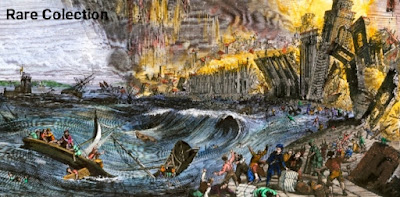Top 10 Historical Earthquakes in the World
Introduction:
Earthquakes have shaped the world throughout history, leaving lasting impacts on civilizations and landscapes. These powerful natural disasters can cause widespread destruction and loss of life. In this article, we will explore the top 10 historical earthquakes that have significantly influenced our planet.
1. The Great Chilean Earthquake (1960)
The Great Chilean Earthquake, also known as the Valdivia Earthquake, occurred on May 22, 1960. It holds the record for being the most powerful earthquake ever recorded, with a magnitude of 9.5. The quake triggered devastating tsunamis that affected not only Chile but also distant coastal regions, including Hawaii, Japan, and the Philippines.
2. The Great East Japan Earthquake (2011)
On March 11, 2011, the Great East Japan Earthquake walked off the Pacific seacoast of Tohoku. With a magnitude of 9.0, it caused widespread destruction, including a massive tsunami that reached heights of up to 40 meters. The disaster resulted in the loss of thousands of lives and led to the Fukushima nuclear accident, making it one of the most catastrophic earthquakes in modern history.
3. The Sumatra-Andaman Earthquake (2004)
The Sumatra-Andaman Earthquake, which occurred on December 26, 2004, stands as one of the deadliest earthquakes in recorded history. With a magnitude of 9.1 to 9.3, it triggered a devastating tsunami that affected multiple countries, including Indonesia, Thailand, India, Sri Lanka, and the Maldives. The disaster claimed the lives of approximately 230,000 people.
4. The San Francisco Earthquake (1906)
In the early morning hours of April 18, 1906, the San Francisco Earthquake struck the city of San Francisco, California. With an estimated magnitude of 7.8, it caused widespread destruction and resulted in a massive fire that ravaged the city for days. This earthquake remains one of the most significant events in the history of San Francisco.
5. The Shaanxi Earthquake (1556)
The Shaanxi Earthquake, also known as the Huaxian Earthquake, occurred on January 23, 1556, in the Shaanxi province of China. With an estimated magnitude of 8.0, it is considered one of the deadliest earthquakes in recorded history. The disaster caused the loss of approximately 830,000 lives and resulted in the destruction of numerous cities and villages.
6. The Indian Ocean Earthquake and Tsunami (2004)
The Indian Ocean Earthquake, also known as the Boxing Day Tsunami, struck on December 26, 2004. With a magnitude of 9.1 to 9.3, it generated massive tsunamis that affected the coastlines of several countries, including Indonesia, Thailand, Sri Lanka, India, and the Maldives. The catastrophe claimed the lives of over 230,000 people.
7. The Alaska Earthquake (1964)
On March 27, 1964, the Alaska Earthquake, also referred to as the Good Friday Earthquake, shook south-central Alaska. With a magnitude of 9.2, it remains the most powerful earthquake recorded in North American history. The quake caused significant damage to infrastructure, triggered tsunamis, and resulted in the loss of more than 130 lives.
8. The Haiti Earthquake (2010)
The Haiti Earthquake struck the island nation of Haiti on January 12, 2010. With a magnitude of 7.0, it devastated the capital city of Port-au-Prince and its surrounding areas. The disaster caused widespread destruction, claiming the lives of approximately 230,000 people and leaving millions displaced.
9. The Lisbon Earthquake (1755)
The Lisbon Earthquake occurred on November 1, 1755, and is considered one of the deadliest earthquakes in history. It struck the city of Lisbon, Portugal, with an estimated magnitude of 8.5 to 9.0. The quake, followed by fires and tsunamis, resulted in the destruction of a significant portion of the city and caused the loss of tens of thousands of lives.
10. Conclusion:
Earthquakes have left a profound impact on our world, both in terms of human lives lost and the physical changes they bring. The top 10 historical earthquakes mentioned in this article highlight the immense power of these natural phenomena and the devastating consequences they can have on societies and landscapes.
FAQs
Q1: How do earthquakes occur?
Earthquakes do when there's a unforeseen release of energy in the Earth's crust, causing seismic swells.
Q2: Are there any early warning systems for earthquakes?
Yes, some countries have implemented early warning systems that provide a few seconds to minutes of advance notice before an earthquake strikes.
Q3: Can earthquakes be predicted?
Despite advancements in seismology, accurately predicting earthquakes is still a significant challenge.
Q4: Which country experiences the most earthquakes?
Japan experiences the most earthquakes due to its location along the Pacific Ring of Fire.
Q5: How can individuals prepare for earthquakes?
Individuals can prepare for earthquakes by creating an emergency plan, securing heavy objects, and having a disaster supply kit ready.
























0 Comments